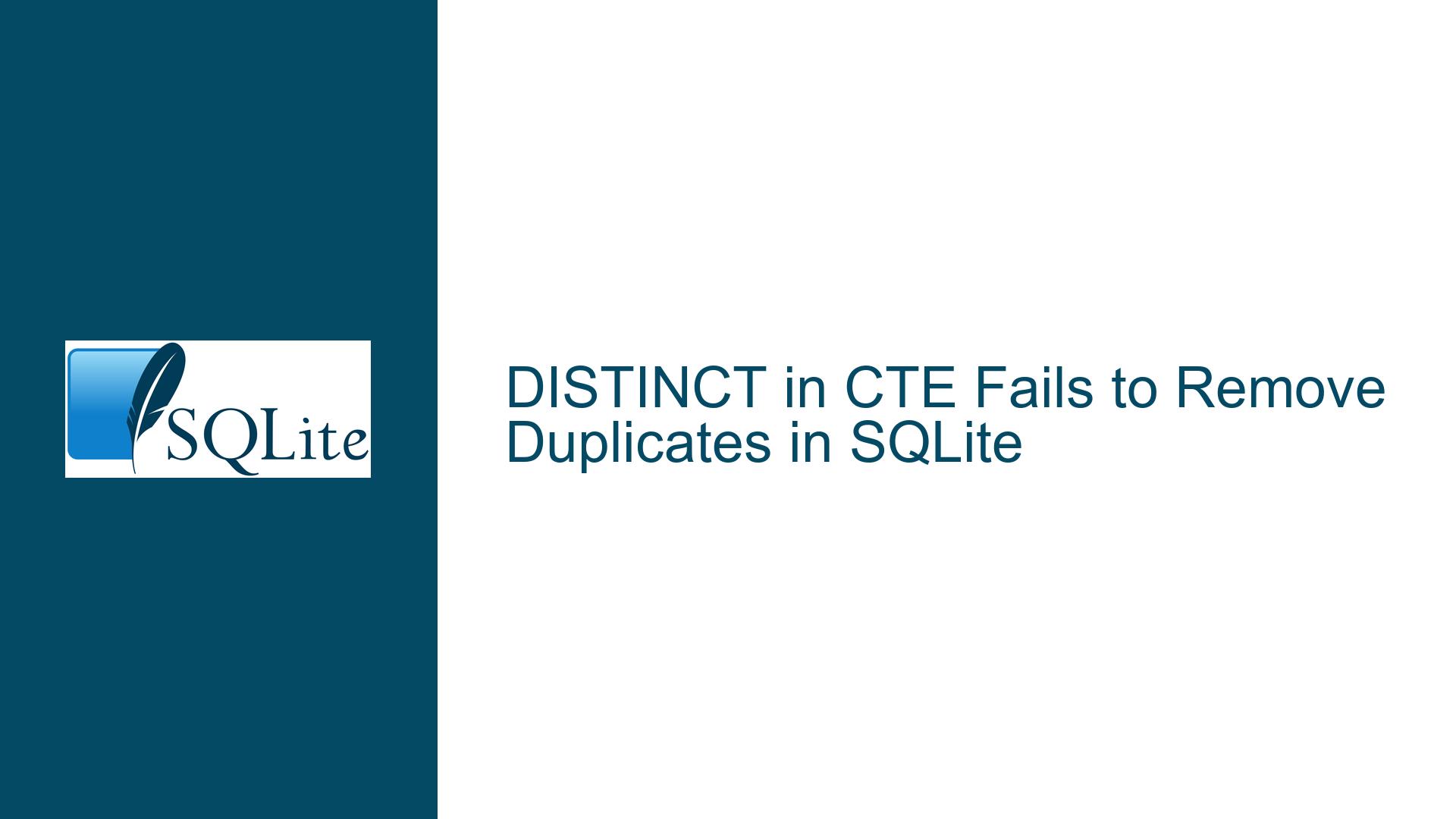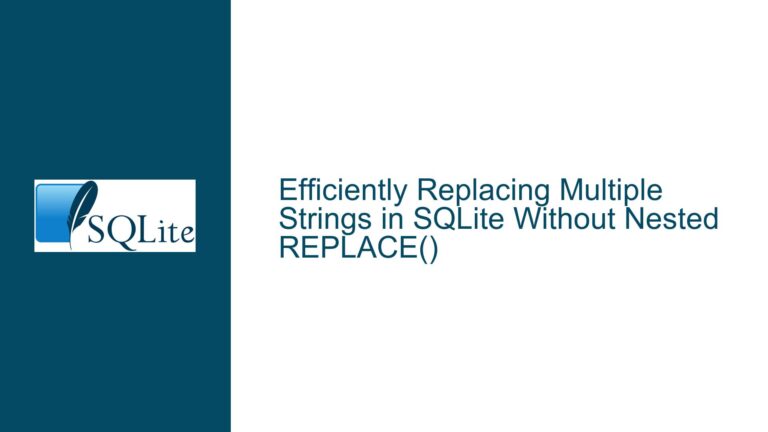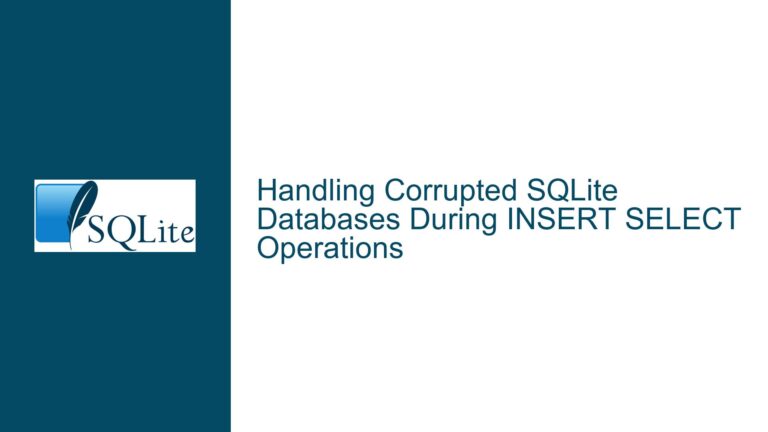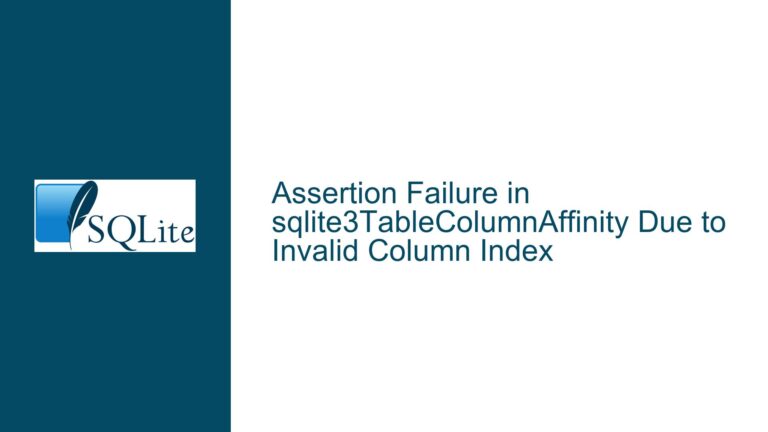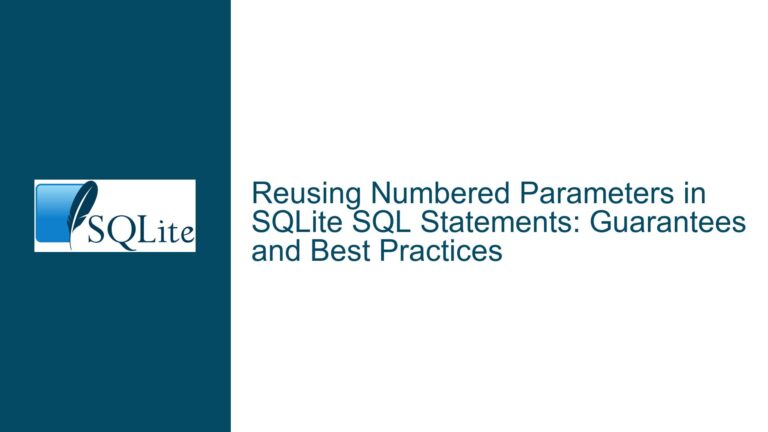DISTINCT in CTE Fails to Remove Duplicates in SQLite
DISTINCT in Common Table Expressions (CTEs) Not Filtering Duplicates
When working with Common Table Expressions (CTEs) in SQLite, particularly recursive CTEs, developers often rely on the DISTINCT keyword to eliminate duplicate rows from the result set. However, a specific issue arises when DISTINCT is used within a recursive CTE, where it fails to remove duplicates as expected. This behavior is particularly noticeable when comparing SQLite’s output with other database systems like PostgreSQL or MySQL, which handle the same query correctly.
Consider the following example:
CREATE TABLE t1 (a);
INSERT INTO t1 VALUES (1), (1), (1), (2);
WITH RECURSIVE r1 AS (
SELECT DISTINCT a, a b FROM t1
UNION ALL
SELECT a, b+1 b FROM r1 WHERE b < 3
)
SELECT * FROM r1;
In this query, the DISTINCT keyword is applied in the initial part of the recursive CTE to ensure that only unique rows are selected from the base table t1. The expectation is that the DISTINCT operation will remove duplicate rows, and the recursive part of the CTE will build upon this unique set. However, SQLite’s output includes duplicate rows, which contradicts the expected behavior.
Expected Output (Other Databases):
a|b
1|1
2|2
1|2
2|3
1|3
Actual Output (SQLite):
a|b
1|1
1|1
1|1
2|2
1|2
1|2
1|2
2|3
1|3
1|3
1|3
The issue is not limited to the recursive part of the CTE but is rooted in how SQLite processes the DISTINCT keyword within the CTE’s initial query. This discrepancy highlights a subtle but significant difference in SQLite’s implementation of CTEs compared to other database systems.
Ambiguity in Column Aliasing and WHERE Clause Interaction
One of the underlying causes of this issue is the interaction between column aliasing and the WHERE clause in recursive CTEs. In the example query, the column b is aliased in both the initial and recursive parts of the CTE. Specifically, the recursive part of the CTE uses the expression b+1 and aliases it as b. This creates ambiguity in how SQLite interprets the column b in the WHERE clause.
In SQLite, the WHERE clause in the recursive part of the CTE appears to reference the original value of b rather than the aliased value b+1. This behavior differs from other databases, where the WHERE clause would reference the aliased value. For example, if the recursive part of the CTE is modified to use a different alias for b+1, such as c, the query produces the expected output:
WITH RECURSIVE r1 AS (
SELECT DISTINCT a, a b FROM t1
UNION ALL
SELECT a, b+1 c FROM r1 WHERE c < 3
)
SELECT * FROM r1;
This modification resolves the ambiguity and aligns SQLite’s output with that of other databases. However, this workaround does not address the root cause of the issue, which is the failure of the DISTINCT keyword to remove duplicates in the initial part of the CTE.
The ambiguity in column aliasing and WHERE clause interaction is a critical factor in this issue. It underscores the importance of understanding how SQLite processes recursive CTEs and the potential pitfalls of reusing column names in recursive queries.
Resolving DISTINCT Issues in Recursive CTEs with SQLite Updates and Best Practices
To address the issue of DISTINCT failing to remove duplicates in recursive CTEs, developers can take several steps. The first and most straightforward solution is to update to the latest version of SQLite. As noted in the discussion, this issue was identified and fixed in the SQLite trunk. Updating to a version that includes this fix will resolve the problem without requiring changes to the query.
For developers who cannot immediately update their SQLite version, there are alternative approaches to achieve the desired behavior. One such approach is to use a subquery or a temporary table to enforce uniqueness before the recursive part of the CTE. For example:
CREATE TABLE t1 (a);
INSERT INTO t1 VALUES (1), (1), (1), (2);
WITH RECURSIVE r1 AS (
SELECT a, a b FROM (SELECT DISTINCT a FROM t1)
UNION ALL
SELECT a, b+1 b FROM r1 WHERE b < 3
)
SELECT * FROM r1;
In this modified query, the DISTINCT operation is applied in a subquery that selects from t1, ensuring that only unique rows are passed to the recursive part of the CTE. This approach effectively eliminates duplicates and produces the expected output.
Another best practice is to avoid reusing column names in recursive CTEs, especially when performing arithmetic operations or other transformations. Using distinct column names for aliased expressions can prevent ambiguity and ensure that the WHERE clause references the correct values. For example:
WITH RECURSIVE r1 AS (
SELECT DISTINCT a, a AS initial_b FROM t1
UNION ALL
SELECT a, initial_b + 1 AS next_b FROM r1 WHERE next_b < 3
)
SELECT * FROM r1;
In this query, the initial value of b is aliased as initial_b, and the recursive transformation is aliased as next_b. This naming convention clarifies the purpose of each column and avoids confusion in the WHERE clause.
Finally, developers should be aware of the differences in how SQLite and other databases handle recursive CTEs. While SQLite is a powerful and lightweight database, its implementation of certain features may differ from other systems. Understanding these differences and adopting best practices can help avoid issues and ensure consistent behavior across database systems.
In conclusion, the issue of DISTINCT failing to remove duplicates in recursive CTEs in SQLite is a nuanced problem that stems from the interaction between column aliasing and the WHERE clause. By updating to the latest version of SQLite, using subqueries or temporary tables to enforce uniqueness, and avoiding ambiguous column names, developers can resolve this issue and achieve the desired query behavior. These steps not only address the immediate problem but also contribute to more robust and maintainable SQL code.
